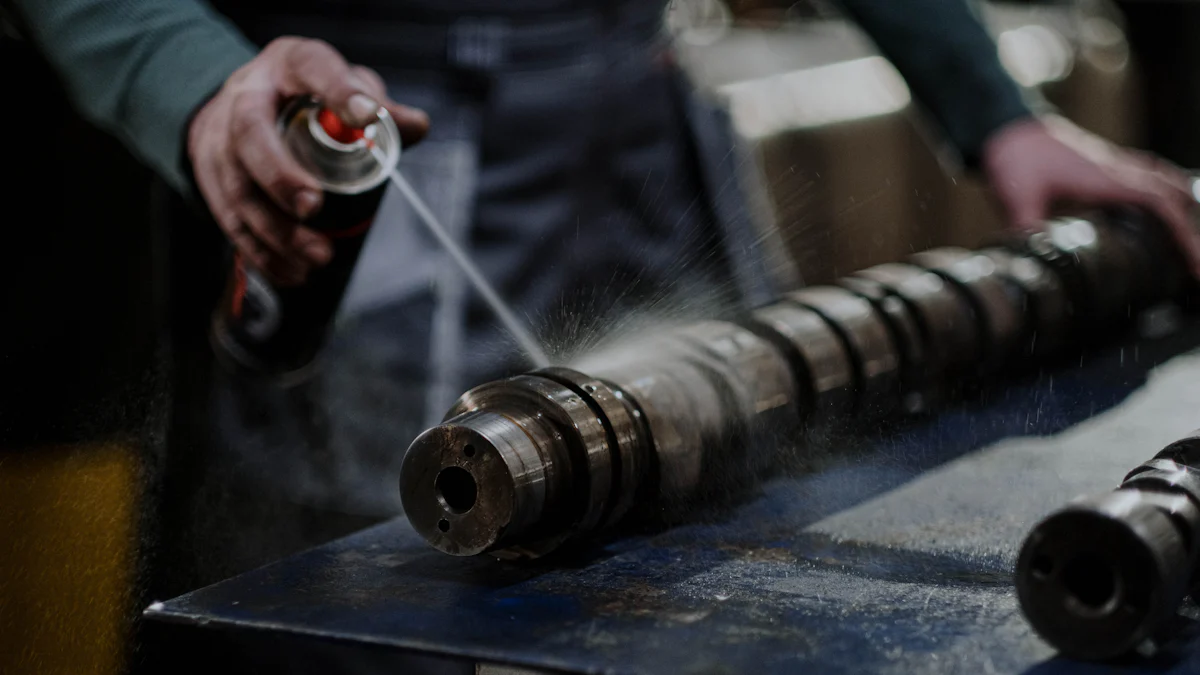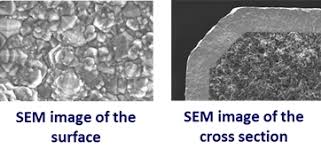![]()
炭化ケイ素のコーティングβ-SiCの薄膜は、耐久性と抵抗性に優れ、材料の表面特性を高めます。 この高度なコーティング技術は、高温、腐食性環境、機械的摩耗など、極端な条件に耐える材料を強化します。 業界に頼る SIC coating 優れた熱安定性と耐薬品性を発揮します。 適用 のような SICの特長 タックコーティング 特殊用途の適応性をさらに発揮します。 伝統とは違って silicon coatingシリコンカーバイドは、航空宇宙、半導体、再生可能エネルギーなどの分野に欠かせない性能を発揮します.
要点
- 炭化ケイ素のコーティングは材料をより強くし、堅い条件を扱うことができます。 お問い合わせ 航空機のような企業のために大きい そして電子工学.
- その硬さは、ツールに役立ちます そして機械は荒い環境で長く持続します.
- 炭化ケイ素は1,000°C以上の温度でも強いまま、非常に熱い場所でよく働きます.
- 化学物質からの錆や損傷に抵抗し、修理を切断し、お金を節約します.
- コーティングは熱をすぐに広がり、部品を余りに熱することを停止します.
- 小さな部分や細かい部分を保護し、トリッキー形状を均等にカバーできます.
- 炭化ケイ素のコーティングを使用してより少しの苦境および取り替えを必要とすれば時間の上のお金を節約します.
- それは車および緑のエネルギー システムのより少ないエネルギーそして低下の汚染を使用して環境を助けます.
シリコンカーバイドコーティングとは?
Definition and Composition
Silicon Carbide Coating β-SiCの防護層を各種表面に適用し、性能を高めます。 このコーティングは結晶構造で整理されるケイ素およびカーボン原子から成っています。 β-SiC の形態、別名立方炭化ケイ素は、優秀な機械および熱特性のために、一般に使用されます。 メーカーは、化学蒸気蒸着(CVD)や物理的な蒸気沈着(PVD)などの高度な技術を使用して、このコーティングを適用します。 これらの方法は、基板に強く付着する均一で耐久性のある層を保証します.
炭化ケイ素の組成物は、ユニークなものにします。 シリコン原子と炭素原子間の同等接合により、硬度と安定性が抜群です。 この構造は、コーティングが高温や研磨環境を含む極端な条件に耐えることを可能にします。 素材の軽量化により、高機能なソリューションを必要とする業界への魅力をさらに高めます.
主な特徴と意義
シリコンカーバイドコーティングは、現代の産業に不可欠であるいくつかの驚くべき特性を展示しています。 その高い硬度は、モーススケールのダイヤモンドの近くでランク付けされ、摩耗および摩耗への例外的な抵抗を提供します。 このプロパティは、要求の厳しいアプリケーションでも、耐久性を延ばすことができます.
熱安定性は別の重要な特徴です。 1000°Cを超える温度で構造の整合性を維持し、高温環境に最適です。 また、その優れた熱伝導性により、半導体や航空宇宙部品などの用途に重要な効率的な熱放散を実現します.
耐食性は更にその実用性を高めます。 炭化ケイ素は酸、アルカリおよび酸化の代理店からの化学攻撃に抵抗し、粗い環境の長期性能を保障します。 化学的不活性は、他の材料との反応を防止し、敏感な用途に適しています.
産業は装置の寿命そして信頼性を改善する機能のためのこのコーティングを評価します。 摩耗や腐食を抑えることで、メンテナンスコストとダウンタイムを最小限に抑えます。 軽量化した自然は、エネルギー効率、特に輸送や航空宇宙分野にも貢献しています.
ヒント 炭化ケイ素 コーティングは強さ、耐久性および熱効率の組合せを要求する適用のための優秀な選択です.
炭化ケイ素コーティングの主な特徴

高い硬度および耐久性
シリコンカーバイドコーティングは、その優れた硬度で有名で、モーススケールのダイヤモンドのすぐ下でランキングされています。 この高い硬度は摩耗および摩耗に対して非常に抵抗力がある、極度な機械圧力の下で摩耗します。 一定の摩擦や衝撃で環境で動作する産業は、このプロパティから大幅に利益をもたらします。 たとえば、シリコンカーバイドでコーティングされた工具や機械が表面の劣化を少なくし、運用寿命を延ばします.
このコーティングの耐摩耗性はまた頻繁な維持のための必要性を減らします。 ポンプやバルブなどの産業機器のコンポーネントは、長期にわたって構造的完全性を維持します。 この耐久性は、マイニングや製造などの研磨条件でも、一貫した性能を保証します。 摩耗を最小化することにより、シリコンカーバイドコーティングは信頼性を高め、ダウンタイムを削減し、高需要用途向けの費用対効果の高いソリューションを実現します.
優れた熱安定性
炭化ケイ素のコーティングは驚くべき熱安定性を、1,000°Cを超過する温度で特性を維持します。 炉、タービン、航空宇宙部品など高温環境での用途に最適な特長です。 熱の下で強さを低下させ、または失う多くの材料とは異なり、炭化ケイ素は、その構造的完全性を保持し、一貫した性能を保証します.
熱衝撃に耐える能力は、その魅力をさらに高めます。 急速な温度変化は、材料が割れたり変形したりすることが多いが、炭化ケイ素はこれらの圧力を効果的に抵抗します。 この特性は、精密な熱管理が重要である半導体のような企業で特に価値があります。 コーティングの優れた熱伝導性は、効率的な熱放散にも役立ちます。過熱を防ぎ、全体的なシステム効率を改善します.
Corrosion and Oxidation Resistance
炭化ケイ素のコーティングは粗い化学環境の腐食および酸化への顕著な抵抗、提供します。 耐薬品性は、酸、アルカリ、酸化剤との反応を防止し、長期的な耐久性を確保します。 この抵抗は腐食性物質への露出が共通である化学処理のような企業のためのそれの好まれた選択をします.
耐薬品性に加え、高温での酸化から保護します。 高温で空気にさらされたときに酸化する多くの材料は、表面劣化につながる。 シリコンカーバイドは、このプロセスを防止する保護障壁を形成し、材料の完全性を維持します。 腐食および酸化へのこの二重抵抗は部品の寿命を拡張しま、取り替えの費用を減らし、操作上の効率を高めます.
注: 耐摩耗性、熱安定性、耐腐食性の組み合わせにより、炭化ケイ素コーティングは、要求の厳しい産業用途に多目的なソリューションを提供します.
High Thermal Conductivity
シリコンカーバイドコーティングは、卓越した熱伝導性、高性能なアプリケーションにおいて重要な役割を果たしている特性を際立っています。 このコーティングは熱を効率的に移し、コンポーネントが激しい運用条件下でも冷却されるようにします。 半導体や航空宇宙などの産業は、システムの性能と信頼性を高めるために、この機能に大きく依存しています.
炭化ケイ素のコーティングの高い熱伝導性は急速な熱放散を可能にします。 過熱を防止し、材料の劣化やシステム障害につながることができます。 たとえば、半導体製造では、精密な熱管理は、繊細なコンポーネントの完全性を維持するために不可欠です。 炭化ケイ素のコーティングは操作の間に発生する熱がすぐに分散し、敏感な装置を保護し、全面的な効率を改善することを保障します.
ヒント 炭化ケイ素と塗られる部品は過熱の危険なしでより高い電力レベルで、それらを要求する環境のための理想を作ることができます作動できます.
このプロパティのもう一つの利点は、エネルギー効率への貢献です。 有効な熱伝達を促進することによって、炭化ケイ素のコーティングは冷却装置に必要なエネルギーを減らします。 運用コストを下げるだけでなく、エネルギー消費を最小限にすることで、持続的な取り組みをサポートします。 太陽光パネルや風力タービンなどの再生可能エネルギーへの応用は、この機能に大きな利益をもたらします.
高温での熱伝導性を維持するためのコーティングの能力は、さらにその魅力を高めます。 極端な熱の下で熱伝達能力を失う多くの材料とは異なり、炭化ケイ素は効果的です。 ガスタービンや工業炉など高温用途に適しています.
化学成分
シリコンカーバイドコーティングの特徴は、化学的不活性です。 このプロパティは、酸、アルカリ、酸化剤を含む様々な化学物質に曝露したときにコーティングが安定して非反応状態に保つことを保証します。 化学加工や医薬品などの過酷な化学環境に対処し、機器を保護し、性能を維持する能力を発揮します.
炭化ケイ素のコーティングは基質および周囲の環境間の化学反応を防ぐ強い障壁を形作ります。 この保護は頻繁に取り替えのための必要性を減らす部品の寿命を拡張します。 たとえば、化学反応器では、コーティングは腐食性物質から内部表面をシールドし、時間をかけて一貫した動作を保証します.
注: 炭化ケイ素のコーティングの化学不活性はまた敏感な材料を含む適用のために適しています。 汚染を防ぎ、プロセスの完全性が妥協されていないことを保証します.
この特性は、化学反応が起こる可能性が高い高温環境で特に有益です。 炭化ケイ素のコーティングは酸化および他の化学変化に抵抗し、極度な条件の下で構造の完全性を維持します。 長期的な耐久性と性能を必要とする業界に欠かせないソリューションです.
高い熱伝導性および化学不活性の組合せは広範囲の適用のための多目的で、信頼できる選択として炭化ケイ素のコーティングを置きます。 熱および化学的安定性を増強する能力は、現代の産業課題の要求を満たしていることを確認します.
Advantages of Silicon Carbide Coating
耐久性と寿命の向上
炭化ケイ素のコーティングはかなり 耐久性を高めます 堅牢な保護層を提供することで材料の。 摩耗へのその例外的な硬度そして抵抗は上塗を施してある表面が機械圧力に延長された露出に抗することを確認します。 この耐久性は、修理と交換の頻度を減らし、業界のための時間とリソースを節約します.
炭化ケイ素のコーティングの長寿はそれを粗い環境の適用のための理想的な選択にします。 採鉱装置または産業機械類のような研摩の条件に露出される部品は表面劣化に抵抗する能力からの寄与します。 長期にわたる構造の完全性を維持することによって、コーティングは一貫した性能および信頼性を保障します.
ヒント メンテナンスコストとダウンタイムを最小限に抑える業界は、シリコンカーバイドコーティングを実証した耐久性と長期的な利点を考慮しなければならない.
敏感な適用のための高い純度
について 炭化ケイ素の高純度 コーティングは、汚染のない環境を必要とする産業にとって不可欠です。 その化学的不活性は、半導体および製薬分野での用途に適した、敏感な材料と反応しないようにします.
半導体製造では、微小不純物でも繊細な部品の性能を損なうことができます。 炭化ケイ素のコーティングは製造プロセスの完全性を保障するきれいで、安定した表面を提供します。 同様に、薬剤の生産では、コーティングは汚染を防ぎま、薬および他のプロダクトの質を保護します.
コーティングの純度はまた熱および化学安定性を高め、精密運転された企業の役割を凝固させます。 清浄度の高い性能を維持することで、シリコンカーバイドコーティングは、先進技術と製品の開発をサポートしています.
複雑な幾何学への適応性
シリコンカーバイドコーティングは、複雑な幾何学に著しい適応性を発揮し、幅広い用途に適しています。 化学蒸気沈着(CVD)のような高度の沈着の技術は、コーティングが厳密な形および表面に合わせるようにします。 この柔軟性は、チャレンジングなデザインを持つコンポーネントでも、均一なカバレッジを保証します.
タービンブレード、熱交換器、マイクロエレクトロニクス機器などのコーティング部品において、この適応性を発揮します。 これらのコンポーネントは、正確なコーティングアプリケーションを必要とする複雑な設計をしばしば特徴付けます。 炭化ケイ素のコーティングはあらゆる表面が、複雑さに関係なく、保護および性能の強化の同じレベルを受け取ることを保障します.
注: 妥協のない品質で複雑な幾何学をコートする能力は、炭化ケイ素は、現代のエンジニアリングの課題のための多目的なソリューションをコーティングします.
コーティングの適応性は、金属、セラミックス、複合材など、さまざまな基材にも及ぶ。 この汎用性により、さまざまな用途でシリコンカーバイドコーティングを適用し、その実用性と有効性を最大限に高めることができます.
高性能アプリケーションにおけるコスト効果
炭化ケイ素のコーティングは高性能材料を要求する企業のための費用効果が大きい解決を提供します。 コンポーネントの耐久性と効率性を高める能力は、頻繁な交換の必要性を減らし、大幅なコストを時間をかけて節約できます。 機械および装置の寿命を延ばすことによって、このコーティングは企業のための経済的な選択をする操作上の中断および維持費を最小にします.
主要な方法の1つは炭化ケイ素のコーティングが費用効果が大きい達成します例外的な耐久性によってです。 この材料の経験によって塗られる部品は研摩の環境で、より少ない表面劣化を、減らします。 この耐久性は、全体の運用コストを削減するより少ない修理と交換に翻訳します。 たとえば、採掘や製造のメリットで使用される産業機器は、ダウンタイムとメンテナンスを削減し、途切れない生産性を保証します.
炭化ケイ素のコーティングの熱安定性はまた経済的利点に貢献します。 高温での構造的完全性を維持することで、熱応力による損傷を防ぎます。 このプロパティは、極端な熱の下で機器が動作する航空宇宙やエネルギーなどの業界で特に価値があります。 このような条件に耐えるコーティングの能力は、頻繁な部品交換の必要性を排除し、長期的な費用を削減します.
コスト効果を高めるもう一つの要因は、様々な基質や複雑な幾何学に対するコーティングの適応性です。 高度な蒸着技術は、均一なアプリケーション、複雑な表面でも保証します。 この汎用性により、業界は幅広いコンポーネントにわたってコーティングを適用し、そのユーティリティを最大限に活用することができます。 複数の部品を単一のソリューションで保護することにより、企業がプロセスを合理化し、材料コストを削減することができます.
エネルギー効率は、炭化ケイ素コーティングの経済的魅力をさらに高めます。 高い熱伝導性により、冷却システムに必要なエネルギーを削減し、効果的な熱放散を促進します。 運用コストを削減するだけでなく、エネルギー消費を最小限にすることで、持続可能性への取り組みをサポートします。 太陽光や風力などの再生可能エネルギーの産業は、これらの節約に大きな利益をもたらします.
ヒント 炭化ケイ素のコーティングに投資することは特に要求する環境で作動する企業のための時間上の実質のコスト節約に導くことができます.
耐久性、熱安定性、エネルギー効率のコンビネーションは、炭化ケイ素コーティングを高機能用途の費用対効果の高い選択肢として位置します。 メンテナンスを削減し、機器の寿命を延ばし、エネルギー使用を最適化する能力は、企業のための長期的な経済的利益を保証します.
Applications of Silicon Carbide Coating

Semiconductor Industry
半導体業界は、あらゆる工程において精度と信頼性が求められます。 シリコンカーバイドコーティングは、半導体製造装置の性能向上に重要な役割を果たしています。 その例外的な熱安定性は部品がウエファーの製作の間に要求される高温に耐えることができることを保障します。 コーティングの耐薬品性は汚染を防ぎ、製造環境の純度を維持します.
チャンバー、蒸着ツール、ウエハキャリアのエッチングは、このコーティングから大幅に有効です。 これらのコンポーネントを摩耗や腐食から保護し、運用寿命を延ばします。 また、繊細な半導体材料の完全性を維持するために不可欠である効率的な熱放散における高い熱伝導性補助。 耐久性および熱管理を改善することによって、炭化ケイ素のコーティングは高度のマイクロチップおよび電子機器の生産を支えます.
注: 半導体製造における炭化ケイ素コーティングの使用は、一貫した性能を確保し、ダウンタイムを削減し、この業界に不可欠です.
再生可能エネルギーセクター
再生可能エネルギーシステムは、過酷な環境条件に耐えることができる材料を必要とします。 炭化ケイ素のコーティングは耐久性および効率をのために必要としました提供します 太陽電池パネルの適用風力タービンおよびエネルギー貯蔵システム。 熱伝導率が高く、エネルギー変換効率を向上し、熱を効果的に散らすことにより、太陽電池の性能を向上します.
風力タービンでは、コーティングは軸受けのような重要な部品を保護し、要素への一定した動きおよび露出によって引き起こされる摩耗および腐食からギヤは防ぎます。 同様に、エネルギー貯蔵システムでは、それは化学分解に抵抗することによって電池の部品の長寿を保障します。 これらの特性は、シリコンカーバイドコーティングを持続可能なエネルギーソリューションへの移行に価値のある資産にします.
ヒント 再生可能エネルギーシステムの効率性と寿命を向上させることにより、炭化ケイ素コーティングは、運用コストの削減と環境の持続可能性の支援に貢献します.
航空宇宙・防衛
航空宇宙および防衛分野は、最も要求の厳しい環境で動作します。 炭化ケイ素のコーティングは極度な温度、機械圧力および腐食性の条件に露出される部品のための強さそして弾性を提供します。 軽量な性質により、航空機エンジンや宇宙船部品など重量削減が重要である用途に最適です.
熱安定性は大気空間の適用の主利点です。 コーティングは、タービンブレード、熱シールド、排気システムが高温条件下でその完全性を維持することを保証します。 防衛では、レーダーシステムやミサイルコンポーネントなどの装置を摩耗や環境損傷から保護します。 耐久性、熱効率、耐薬品性の組み合わせにより、炭化ケイ素コーティングは、ミッションクリティカルな用途に信頼できるソリューションを提供します.
コールアウト 炭化ケイ素のコーティングは大気および宇宙空間および防衛システムの信頼性そして性能を高めます、それらはこれらの企業の厳密な要求に応じることを保障します.
Automotive and Transportation
効率性を維持しながら極端な条件に耐えることができる自動車および輸送業界要求材料。 炭化ケイ素のコーティングは車および交通機関システムで重要な部品の性能を高めます。 コンセプト 例外的な耐久性 エンジン部品やブレーキングシステムなどの一定の摩擦に従った部品が耐久性に保たれていることを確認してください。 この耐久性は、メンテナンス要件を減らし、これらのコンポーネントの寿命を延ばし、メーカーにとって費用対効果の高いソリューションです.
熱安定性は自動車適用の別の主利点です。 エンジンおよび排気システムは保護されていない材料を劣化させることができる高温で作動します。 シリコンカーバイドコーティングは、これらの条件に耐える保護バリアを提供し、一貫した性能を保証します。 また、熱放散の熱伝導性が高く、過熱防止、エネルギー効率の向上にも貢献しています。 電池の性能および安全のために熱管理が重要である電気自動車で特に価値があります.
炭化ケイ素コーティングの軽量性は、燃費効率に貢献します。 コーティングされた部品全体の重量を減らすことによって、車は操作の間により少ないエネルギーを消費します。 持続可能性と炭素排出量の低減に向け、業界のプッシュと一致します。 また、道路塩や汚染物質などの過酷な環境への曝露による腐食から、コーティングの耐薬品性を保護します.
ヒント 自動車メーカーは、シリコンカーバイドコーティングを活用して、車両の信頼性と効率性を高め、性能と環境目標の両方を満たすことができます.
産業設備および機械類
産業機器および機械類は研摩および高力環境で頻繁に作動します。 シリコンカーバイドコーティングは、摩耗や破損から部品を保護するために必要な耐久性を提供します。 ポンプ、バルブ、切削工具は、摩擦や衝撃による表面劣化を最小限に抑えるため、このコーティングから大幅に利益をもたらします。 この保護は、一貫した性能を確保し、ダウンタイムを削減します。これは、産業業務の生産性を維持するために不可欠です.
耐食性は産業適用のための別の必要な特徴です。 化学加工、油、ガスなどの過酷な環境で使用される機器は、腐食性物質への一定の曝露に直面しています。 炭化ケイ素のコーティングは機械の寿命を拡張する化学反応を防ぐ強い障壁を形作ります。 腐食へのこの抵抗はまた取り替えの頻度を減らします操作費を下げます.
複雑な幾何学に対するコーティングの適応性は、幅広い産業コンポーネントに適しています。 高度な蒸着技術は、均一なカバレッジ、複雑な表面でも保障します。 この汎用性により、メーカーはさまざまな部品にコーティングを適用し、性能と信頼性を高めることができます。 また、コーティングの高熱伝導性は、運転中に重要な熱を発生させる装置で効率的な熱管理をサポートします.
コールアウト 摩耗、腐食および熱圧力から産業装置を保護することによって、炭化ケイ素のコーティングは企業のための長期信頼性そして費用節約を保障します.
炭化ケイ素コーティングプロセス
コーティング技術の概要
Manufacturers use 応用する高度の技術 炭化ケイ素のコーティングは、精密および耐久性を保障します。 化学蒸気蒸着(CVD)は最も一般的な方法の1つです。 熱心な基質の気体の前駆体の反応を伴い、均一で密なコーティングを形成します。 高清浄度レイヤーを生み出す技術で、半導体などの敏感な用途に理想的です.
物理的な蒸気蒸着(PVD)は別の広く使用される方法です。 真空条件下で材料をソースから基質への物理的搬送に依存します。 PVDは優秀な付着を提供し、コーティングの複雑な幾何学のために適しています。 プラズマスプレーを含む熱噴霧もより厚いコーティングに採用されます。 高温プラズマを使用して、炭化ケイ素粒子を表面に溶かし、分解します.
各技術は、業界がアプリケーション要件に基づいて最も適切な方法を選択できるように、ユニークな利点を持っています.
ヒント 適切なコーティング技術を選択すると、特定の産業ニーズに最適な性能とコスト効率を保証します.
炭化ケイ素のコーティングのために適した材料
シリコンカーバイドコーティングは、幅広い材料に適用でき、要求の厳しい環境のためにその特性を強化することができます。 ステンレス鋼やチタンなどの金属は、耐摩耗性や熱安定性の向上に寄与します。 アルミナおよびジルコニアを含む陶磁器は、化学攻撃に対する付加的な強さそして保護を得ます.
シリコンカーバイドコーティングの優れた基質にもコンポジット。 これらの材料は、航空宇宙および自動車のアプリケーションで頻繁に使用され、高められた耐久性および減らされた重量を達成します。 ガラスおよび水晶は半導体および光学のような高純度の表面を、要求する企業で他の適した候補者、特にです.
多様な材料を持つ炭化ケイ素コーティングの両立性は、その汎用性と広範な産業応用性を強調しています.
注: より強い付着およびコーティングの長続きがする性能を保障するために適切な表面の準備は重大です.
コーティングプロセスにおける課題とイノベーション
炭化ケイ素のコーティングを適用すると、いくつかの課題があります。 複雑な幾何学の均一なカバレッジを達成することは、特に複雑なコンポーネントのために困難であることができます。 また、蒸着方法に必要な高温は熱感度基材での使用を制限する場合があります.
コーティング技術の革新は、これらの課題に引き続き対処します。 高度なCVDとPVD技術により、コーティング厚さと組成を正確に制御できるようになりました。 研究者は、対応材料の範囲を拡大するために低温蒸着方法も探しています.
オートメーションとロボティクスは、コーティングプロセスの効率性と一貫性を改善しました。 生産コストを削減し、大規模アプリケーション向けのスケーラビリティを高めます.
コールアウト シリコンでのイノベーションの開始 炭化物のコーティング プロセスは企業がより大きい効率の進化した性能の要求に応じることができることを保障します.
なぜ炭化ケイ素のコーティングを選ぶか?
代替コーティングとの比較
シリコンカーバイドコーティングは、他の保護コーティングと比較して際立つ プロパティのユニークな組み合わせ. . クロムやニッケルメッキなどの伝統的なコーティングは、基本的な耐摩耗性を提供しますが、極端な条件下では失敗します。 一方、シリコンカーバイドコーティングは、優れた硬度、熱安定性、耐薬品性を提供し、高性能な用途に適しています.
たとえば、ポリマーベースのコーティングは腐食に抵抗するかもしれませんが、研磨環境に必要な耐久性が欠けています。 同様に、セラミックコーティングは熱抵抗で優れていますが、多くの場合、機械的ストレスの下で亀裂します。 シリコンカーバイドコーティングは、バランスの取れたソリューションを提供することで、これらのギャップを埋めます。 高温と機械的摩耗に耐える能力は、長期にわたる信頼性を保証します.
ヒント 摩耗、熱および化学抵抗のための単一の解決を要求する企業は従来の選択上の炭化ケイ素のコーティングを考慮するべきです.
コスト効率性は、シリコンカーバイドコーティングを別々に設定する別の要因です。 初期投資は、いくつかの選択肢よりも高いかもしれませんが、その耐久性はメンテナンスと交換コストを時間をかけて削減します。 これは、要求の厳しい環境で動作する業界のためのより経済的な選択肢になります.
産業の長期的利点
について 炭化ケイ素のコーティングの長期利点 様々な業界に広がる その例外的な耐久性は、コンポーネントの寿命を高め、頻繁な交換の必要性を減らします。 この信頼性はダウンタイムを最小限に抑え、製造、航空宇宙、エネルギーなどの分野における中断のない操作を保証します.
耐久性に加えて、コーティングの熱安定性は高温環境の効率的な性能をサポートします。 たとえば、炭化ケイ素でコーティングされたタービンブレードは、極端な熱の下でその完全性を維持し、エネルギー効率を改善し、運用リスクを削減します。 同様に、その化学不活性は、化学処理プラントの装置を保護し、時間をかけて一貫した性能を保証します.
コールアウト 機械の寿命を延ばし、維持費を削減することによって、炭化ケイ素のコーティングは重要な経済的な利点を提供します.
コーティングはまた、持続可能性の目標と整列します。 軽量な自然がエネルギー効率、特に交通機関および宇宙空間の塗布に貢献します。 燃料消費量や排出量を削減することで、環境規制を満たす業界をサポートします。 さらに、太陽光パネルや風力タービンなどの再生可能エネルギーシステムの効率性を高める能力は、持続可能な技術の発展に役立てています.
注: シリコンカーバイドコーティングは、性能を向上させるだけでなく、長期的なコスト削減と環境目標を達成するための産業をサポートしています.
シリコンカーバイドコーティングは、耐久性、熱安定性、化学抵抗のユニークな組み合わせを提供し、現代の産業に不可欠です。 極端な条件でのパフォーマンスを向上させる能力は、航空宇宙、半導体、再生可能エネルギーなどのセクターにとって重要なソリューションとして位置付けられました。 今後も、高機能材料の需要が高まる中、炭化ケイ素コーティングの採用が期待されます。 効率を改善し、コストを削減しようとするビジネスは、この高度なコーティング技術を探求し、業務上の課題を効果的に満たす必要があります.
よくあるご質問
炭化ケイ素コーティングの主な目的は何ですか?
炭化ケイ素のコーティング 材料の耐久性、熱安定性、耐薬品性を高めます。 摩耗、腐食、極端な温度から表面を保護し、航空宇宙、半導体、再生可能エネルギーなどの産業における高性能な用途に最適です.
すべての材料に炭化ケイ素のコーティングを加えることができますか?
炭化ケイ素のコーティングは金属、陶磁器、複合材料およびガラスでよく働きます。 但し、基質は化学蒸気の沈殿物(CVD)の間に高温のようなコーティング プロセスの状態に、抗しなければなりません.
炭化ケイ素のコーティングは熱管理を改善する方法か?
コーティングの高い熱伝導性は有効な熱放散を保障します。 半導体や航空宇宙部品などの用途において、過熱、システム性能の向上、エネルギー効率の向上を防止します.
シリコンカーバイドコーティングは環境に優しいですか?
はい、炭化ケイ素のコーティングは装置の寿命を拡張し、維持を減らし、エネルギー効率を改善することによって持続可能性を支えます。 軽量化により、輸送や航空宇宙用途での燃料節約にも貢献します.
What industries benefit most from silicon carbide coating?
航空宇宙、半導体、再生可能エネルギー、自動車、化学加工などの産業は、著しく利益をもたらします。 コーティングのユニークな特性は、これらの分野における摩耗、熱、および化学的暴露の課題に対処します.
炭化ケイ素のコーティングは他のコーティングと比較しますか?
シリコンカーバイドコーティングは、耐摩耗性、熱安定性、耐薬品性のクロムやニッケルめっきなどの従来のコーティングを外します。 要求環境に対応したバランスの取れたソリューションで、高性能な用途に優れた選択肢を提供.
炭化ケイ素のコーティングの限界は何ですか?
コーティングプロセスは高価であり、熱感受性の基質に適さないかもしれません。 複雑な幾何学の均一なカバレッジも挑戦することができますが、蒸着技術の進歩は、これらの問題に引き続き対処します.
シリコンカーバイドコーティングはどのくらいの期間続きますか?
寿命は適用および作動状態によって決まります。 ほとんどの場合、シリコンカーバイドコーティングは部品の耐久性を大幅に拡張し、頻繁な交換とメンテナンスの必要性を軽減します.
ヒント コーティングスペシャリストに相談し、最適なアプリケーション方法を決定し、特定のニーズに最適な性能を保証します.